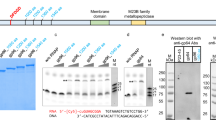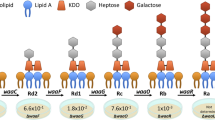Abstract
THE related virulent bacteriophages T3 and T7 code for RNA polymerases which are specific for promoters located on the DNA of these phages1,2. These single peptide chain polymerases—the products of gene 1 (refs 1 and 3)—are genetically homologous but can be distinguished by their template specificity and their molecular weight. The T3 RNA polymerase transcribes T7 DNA at only about 10% of the rate at which T3 DNA is transcribed, and the T7 RNA polymerase transcribes T3 DNA at about 60% the homologous rate2; and, by direct comparison with the T7 polymerase, the molecular weight of the T3 polymerase was found to be about 5% lower than that of the corresponding T7 protein4,5 (whose molecular weight has been estimated at 107,000 (ref. 1), 110,000 (ref. 2), 100,000 (ref. 6), and 108,000 (ref. 4). Since phages T3 and T7 can be crossed7, the differences between the T3 and T7 RNA polymerases provide a model system for studies on the correlation between genetic constitution and functional specificity. Here we report some initial experiments in this direction.
This is a preview of subscription content, access via your institution
Access options
Subscribe to this journal
Receive 51 print issues and online access
$199.00 per year
only $3.90 per issue
Buy this article
- Purchase on Springer Link
- Instant access to full article PDF
Prices may be subject to local taxes which are calculated during checkout
Similar content being viewed by others
References
Chamberlin, M., McGrath, J., and Waskell, L., Nature, 228, 227–231 (1970).
Dunn, J. J., Bautz, F. A., and Bautz, E. K. F., Nature new Biol., 230, 94–96 (1971).
Beier, H., and Hausmann, R., J. Virol., 12, 417–419 (1973).
Issinger, O. G., Dissertation (University of Freiburg, West Germany, 1973).
Schweiger, M., and Herrlich, P., Curr. Top. Microbiol. Immun., 65 (in the press).
Studier, F. W., Science, 176, 367–376 (1972).
Hausmann, R. L., Almeida Magalhaes, E. P., and Araujo, C., Anais Microbiol., 9, 511–526 (University of Brazil Rio de Janeiro, 1961).
Beier, H., Dissertation (University of Freiburg, West Germany, 1973).
Issinger, O. G., Beier, H., and Hausmann, R., Molec. gen. Genet., 122, 81–88 (1973).
Davis, R. W., and Hyman, R. W., J. molec. Biol., 62, 287–301 (1971).
Gefter, M., Hausmann, R., Gold, M., and Hurwitz, J., J. biol. Chem., 241, 1995–2006 (1966).
Studier, F. W., J. molec. Biol., 79, 237–248 (1973).
Author information
Authors and Affiliations
Rights and permissions
About this article
Cite this article
BEIER, H., HAUSMANN, R. T3 × T7 phage crosses leading to recombinant RNA polymerases. Nature 251, 538–540 (1974). https://doi.org/10.1038/251538a0
Received:
Revised:
Issue Date:
DOI: https://doi.org/10.1038/251538a0
Comments
By submitting a comment you agree to abide by our Terms and Community Guidelines. If you find something abusive or that does not comply with our terms or guidelines please flag it as inappropriate.



